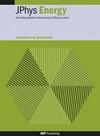通过还原光聚合和直接墨水书写的钠离子电池的多工序3D打印
IF 6.3
3区 材料科学
Q1 ENERGY & FUELS
引用次数: 0
摘要
在这项工作中,报告了用多工艺增材制造打印形状符合电池的能力。采用还原光聚合(VPP) 3D打印工艺制造钠离子电池(sib)用凝胶聚合物电解质(gpe),采用直接墨水书写工艺制备正极。钠离子化学已被证明是锂离子的充分替代品,因为其资源的可用性、潜在的更低的生产成本和更高的安全性。三维打印技术有可能彻底改变具有复杂几何形状的形状符合电池的生产,已被证明可以增加电极的比表面积和离子扩散,从而提高功率性能。本研究展示了具有不同聚合物基质与液体电解质比例的复合紫外光固化树脂的制备,设计用于通过VPP打印的gpe。通过各种电化学技术彻底检查了gpe内液电解质比例的影响。优化了曝光时间打印参数,以确保GPE具有足够的打印精度。以优化后的树脂成分为原料,3D打印的GPE在室温下的离子电导率为3.3 × 10−3 S·cm−1,相对于Na 0 /Na +的稳定窗口高达4.8 V。同时,开发了一种负载Na 0.44 mno2和导电添加剂的复合墨水,通过直接墨水写入正极进行3D打印。在展示了sib中独立3D打印组件的功能之后,本工作的最后一部分重点是将3D打印的Na 0.44 mno2电极和3D打印的GPE结合到同一个电池单元中,为使用不同的增材制造工艺制造完整的3D打印电池铺平道路。本文章由计算机程序翻译,如有差异,请以英文原文为准。
Multiprocess 3D printing of sodium-ion batteries via vat photopolymerization and direct ink writing
Abstract In this work, the ability to print shape-conformable batteries with multi-process additive manufacturing is reported. Vat photopolymerization (VPP) 3D printing process is employed to manufacture gel polymer electrolytes (GPEs) for sodium-ion batteries (SIBs), while direct ink writing process is used to prepare positive electrodes. The sodium-ion chemistry has proven to be an adequate substitute to lithium-ion due to the availability of resources and their potential lower production cost and enhanced safety. Three-dimensional printing technologies have the potential to revolutionize the production of shape-conformable batteries with intricate geometries that have been demonstrated to increase the specific surface area of the electrode and ion diffusion, thus leading to improved power performances. This study shows the preparation of composite UV-photocurable resins with different polymer matrix-to-liquid electrolyte ratios, designed to act as GPEs once printed via VPP. The impact of the liquid electrolyte ratio within the GPEs is thoroughly examined through a variety of electrochemical techniques. The exposure time printing parameter is optimized to ensure adequate print accuracy of the GPE. Using the optimized resin composition as material feedstock, shape-conformable 3D printed GPE exhibiting an ionic conductivity of 3.3 × 10 −3 S·cm −1 at room temperature and a stability window up to 4.8 V vs. Na 0 /Na + is obtained. In parallel, a composite ink loaded with Na 0.44 MnO 2 and conductive additives is developed to 3D print via direct ink writing positive electrodes. After demonstrating the functionality of the independent 3D printed components in SIBs, the last part of this work is focused on combining the 3D printed Na 0.44 MnO 2 electrode and the 3D printed GPE into the same battery cell to pave the way towards the manufacturing of a complete 3D printed battery thanks to different additive manufacturing processes.
求助全文
通过发布文献求助,成功后即可免费获取论文全文。
去求助
来源期刊

Journal of Physics-Energy
Multiple-
CiteScore
10.90
自引率
1.40%
发文量
58
期刊介绍:
The Journal of Physics-Energy is an interdisciplinary and fully open-access publication dedicated to setting the agenda for the identification and dissemination of the most exciting and significant advancements in all realms of energy-related research. Committed to the principles of open science, JPhys Energy is designed to maximize the exchange of knowledge between both established and emerging communities, thereby fostering a collaborative and inclusive environment for the advancement of energy research.
 求助内容:
求助内容: 应助结果提醒方式:
应助结果提醒方式:


